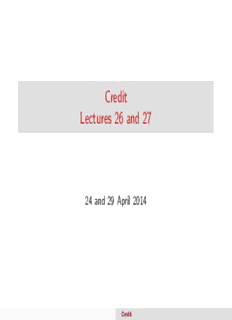
Tuesday April 24, and Thursday April 29, 2014 PDF
Preview Tuesday April 24, and Thursday April 29, 2014
Credit Lectures 26 and 27 24 and 29 April 2014 Credit Operation of the Credit Market Credit may not function smoothly 1. Costly/impossible to monitor exactly what’s done with loan. Consumption? Production? Risky investment? Involuntary default. 2. Borrow has means to pay back loan, but simply finds it not in self interest to do so. Strategic Default Credit Institutional Need (cid:73) Domestic courts of law are often weak or absent. (cid:73) Monitoring of inputs is costly. (cid:73) Lenders use punitive means to enforce repayment (e.g., threat to not lend in the future). (cid:73) Less effective methods are impinge on credit market. Credit Verification Important (cid:73) Not enough to verify output, must be able to verify inputs. (cid:73) Formal institutions (banks) may insufficiently informed to make lending profitable. (cid:73) Informal Institutions arise to fulfill gaps. Credit Sources of demand for credit Basically three: 1. Physical capital — new equipment or structures. 2. Working capital — finance purchase of seeds, fertilizer, ... 3. Consumption — unforeseen need (natural disaster), or large expenditure (wedding) Credit Agriculture Credit most important for working capital and consumption for poor and disadvantaged in developing country. Repay loan after harvest is in. Uncertainty of production makes consumption credit important. Harvest may fail. Moreover, seasonal variation in laborer wages (harvest high, lower in lean season). Credit Rural Credit Market Sources of Credit (cid:73) Institutional Lenders of formal market. Government banks, commercial banks, credit bureaus etc. (cid:73) Informal lenders (large land owners, moneylender) Credit Limitations of Formal Lenders In a nutshell: information Formal lenders ofter without personal knowledge of characteristics and activities of their debtors (clients). Objectives of lender and borrower may diverge. Consider simple example. Let market rate of interest be 10%. A number of alternative projects exist, ea. startup cost of 100,000 Lira. There are two projects one with 15% and the other with 20% return. In absence of uncertainty, and if both projects pay off at the end of next period, projects pay 115,000 and 120,000 Lira. Credit Example continued In this case there is no divergence between lender and borrower. Bank wants its 10% back, and wants borrower to invest in optimal project (20%). (cid:73) Now introduce uncertainty. Assume no uncertainty on 20% return project. (cid:73) Assume Second project has no uncertainty. Return 120,000−100,000 = 20,000. (cid:73) Assume first project returns 230,000 Lira with probability of 1 2 and 0 with probability 1. 2 (cid:73) Lender wants borrow to pursue second project. However, which project does the borrower wish to pursue? (cid:73) Why? Credit Expected Payoff Project 1 Assume borrower able to repay loan if first project fails: 1 1 E[R ] = (230,000−100,000)+ (0−100,000) 1 2 2 1 = −100,000+ (230,000) 2 = 15,000 So, with ability to repay loan if failed, payoff is 15,000 Lira. Less than the payoff from the risk free second project. So, again no divergence between borrower and lender. Credit
Description: